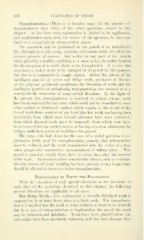Page 652 - My FlipBook
P. 652
;
650 PLANTATION OF TEETH.
Transplantation.—Tliere is a hroadcr range for the ])ractice of
transplantation tlian either of the other operations treated in tliis
ehapter. As has been seen, re])lantation is limited in its a})})lieation,
and implantation must, from the nature of the operation, be also con-
fined to a comparatively circumscribed sphere.
The operation may be performed at any period of an individual's
life, although as a ride young, vigorous, and mature adult life offers the
greatest promise of success. Any socket in any part of the mouth,
when placed in a healthy condition, is a more or less favorable location
for the reception of a tooth about to be transplanted. It is true that
sometimes a socket needs to be enlarged or deepened for this purpose,
but this is a comparatively simple matter. Before the advent of the
intelligent practice of crown and bridge work, treatment of diseases
of the })ulp and jx'ridental membrane, the bleaching of teeth, and the
intelligent practice of orthodontia, transplantation was resorted to as a
remedy for the correction of many trivial disorders. In the light of
the present day, transplantation is confined to sockets whence teeth
have been removed for any cause which could not be remedied by some
other method of treatment : sockets which remain as the result of the
loss of teeth from accident of any kind (the lost teeth not having been
recovered) ; from which roots beyond salvation have been extracted
from which diseased teeth must be removed ; from which roots have
been removed having carried crowns or having served as abutments for
bridges until their period of usefulness has passed.
The same rule laid down for the care of a socket previous to re-
plantation holds good for transplantation ; namely, that inflammation
must be reduced, and the tooth transplanted into the socket at a time
when progressive constructive metamorphosis is taking place. This
period is stated as usually from three to seven days after the removal
of the tooth. In instances where considerable disease, such as a chronic
alveolar abscess of years' standing has been present, even a longer time
.should be allowed to intervene before transplantation.
Preparation of Teeth for Plantation.
With the exception of such special directions as are necessary in
each class of the operations described in this chapter, the following
general directions are applicable to all cases.
The Scion Tooth.—For replantation a recently dislodged tooth is
supposed to be at hand, hence there is a fresh tooth. For transplanta-
tion it is implied that the tooth is either at hand or about to be secured,
but in a case of trans])lantation or implantation the age of the tooth
mav be unknown and indefinite. Teeth have been planted whose age
and origin have been absolutelv unknown, and they have become firm
650 PLANTATION OF TEETH.
Transplantation.—Tliere is a hroadcr range for the ])ractice of
transplantation tlian either of the other operations treated in tliis
ehapter. As has been seen, re])lantation is limited in its a})})lieation,
and implantation must, from the nature of the operation, be also con-
fined to a comparatively circumscribed sphere.
The operation may be performed at any period of an individual's
life, although as a ride young, vigorous, and mature adult life offers the
greatest promise of success. Any socket in any part of the mouth,
when placed in a healthy condition, is a more or less favorable location
for the reception of a tooth about to be transplanted. It is true that
sometimes a socket needs to be enlarged or deepened for this purpose,
but this is a comparatively simple matter. Before the advent of the
intelligent practice of crown and bridge work, treatment of diseases
of the })ulp and jx'ridental membrane, the bleaching of teeth, and the
intelligent practice of orthodontia, transplantation was resorted to as a
remedy for the correction of many trivial disorders. In the light of
the present day, transplantation is confined to sockets whence teeth
have been removed for any cause which could not be remedied by some
other method of treatment : sockets which remain as the result of the
loss of teeth from accident of any kind (the lost teeth not having been
recovered) ; from which roots beyond salvation have been extracted
from which diseased teeth must be removed ; from which roots have
been removed having carried crowns or having served as abutments for
bridges until their period of usefulness has passed.
The same rule laid down for the care of a socket previous to re-
plantation holds good for transplantation ; namely, that inflammation
must be reduced, and the tooth transplanted into the socket at a time
when progressive constructive metamorphosis is taking place. This
period is stated as usually from three to seven days after the removal
of the tooth. In instances where considerable disease, such as a chronic
alveolar abscess of years' standing has been present, even a longer time
.should be allowed to intervene before transplantation.
Preparation of Teeth for Plantation.
With the exception of such special directions as are necessary in
each class of the operations described in this chapter, the following
general directions are applicable to all cases.
The Scion Tooth.—For replantation a recently dislodged tooth is
supposed to be at hand, hence there is a fresh tooth. For transplanta-
tion it is implied that the tooth is either at hand or about to be secured,
but in a case of trans])lantation or implantation the age of the tooth
mav be unknown and indefinite. Teeth have been planted whose age
and origin have been absolutelv unknown, and they have become firm


